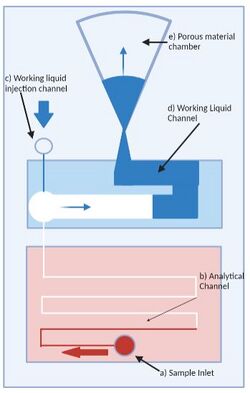SIMPLE paper pumps - Raymond Pho
General Overview
Self-powered Imbibing Microfluidic Pump by Liquid Encapsulation (SIMPLE) is a microfluidic platform that was developed by MeBioS groups at KU Leuven, Belgium. This platform aims to address the need for cost efficient, robust, easy to use, and autonomous for point-of-care (POC) devices. SIMPLE mainly utilizes simple fingertip pressure activation to cause capillary driven flow within the microchannel structure from one end of the device to the other.[1]
Design

The SIMPLE platform has three main parts: (1) the working liquid chamber, (2) the analytical chamber, and (3) the porous material chamber (Figure 1). The device utilizes a combination of capillary valving, actuation with finger tip pressure and paper microfluidics to move fluid. The device can be activated simply by a fingertip press to prove ease of use. Upon activation, the working liquid was absorbed by the porous material, which forces the working liquid to touch the porous material and is absorbed. When the working liquid is absorbed, it causes fluid flow of the sample in the analytical chamber via capillary action. Various passive valves were located throughout the device to prevent controlled flow and leakage.
Working Liquid Chamber
The working liquid is injected into the working liquid inlet channel and fills the working liquid channel up to right before the porous material (see Figure 1). The working fluid can be encapsulated in its respective chambers through prefilling inlets that are sealed by a pressure sensitive adhesive (PSA) foil for storage and contamination prevention. When activated, the working liquid undergoes imbibition by the porous material to drive fluid flow throughout the device via capillary action.[2]
Analytical Chamber
The analytical chamber is where the sample fluid will be injected and flow will be induced upon activation and imbibition of the working liquid. The sample fluid sits in the sample inlet well until the device is activated via the fingertip press and induces the capillary driven fluid flow.[2]
Porous Material Chamber
The porous material chamber contains the medium that imbibes the working liquid to induce fluid flow. The porous material can be a variety of materials; the published method utilized paper for proof-of-concept.[2] In the published method, circular sector geometries of the porous material were used in the design and it was shown that by varying the sector angle, fluid flow could be manipulated. Tested devices typically can control sample volumetric flowrates between the 1-10 μL range, but it is speculated that this could be increased to hundred of μL.[2]
The equation for Q, volumetric flow rate with respect to the sector angle is as follows:[2]
- [math]\displaystyle{ Q = (dV /dt) = (\theta_{c}/360) ∗ \phi2πrh ∗ (dr/dt) }[/math]
Where:
- [math]\displaystyle{ Q }[/math] is the volumetric flow rate of sample fluid
- [math]\displaystyle{ \theta_{c} }[/math] is the sector angle
- [math]\displaystyle{ \phi }[/math] is the porosity of the material
- [math]\displaystyle{ r }[/math] is the wetting radius of the porous material
- [math]\displaystyle{ h }[/math] is the thickness of the porous material
Fabrication
The published method created devices using a digital tabletop craft cutter. The microchannels were designed using a PSA material. With the cut PSA material, it was placed in between two poly(vinyl chloride) (PVC) layers that contain the inlet and passive valve designs. The porous material was also inserted into the porous material chamber during this fabrication process.[1]
Potential Applications
The published method of SIMPLE has been shown to be an easy-to-use platform that can directly translate to many point-of-care (POC) applications and for remote locations with minimal resources. This platform can be easily fabricated and stored in advance for application. SIMPLE has been shown to be adaptable to a variety of applications such has pumping and detection of biological assays.
One published application was in the detection of creatinine in plasma samples with a SIMPLE-based device named Creasensor. Creatinine is an important marker for chronic kidney disease. The microfluidic device was integrated alongside a benchtop colorimeter to quantify levels of creatinine in the samples. The microfluidic device was called "Creacard" and contained two main parts, the pump (SIMPLE) and the detection unit. The two parts were connected by the connection hole. A field study was performed to measure the creatinine levels of 16 plasma samples with concentrations in the range of 0-20 mg/dL. The unknown samples and known samples were measured using the Creasensor and statistical analysis showed an interclass correlation coefficient (ICC) of 0.97.[5]
References
- Kokalj, T.; Park, Y.; Vencelj, M.; Jenko, M.; Lee, L. P. Self-Powered Imbibing Microfluidic Pump by Liquid Encapsulation: SIMPLE. Lab Chip 2014, 14 (22), 4329–4333. https://doi.org/10.1039/c4lc00920g.
- Dal Dosso, F.; Bondarenko, Y.; Kokalj, T.; Lammertyn, J. SIMPLE Analytical Model for Smart Microfluidic Chip Design. Sensors and Actuators A: Physical 2019, 287, 131–137. https://doi.org/10.1016/j.sna.2019.01.005.
- Yeh, E.-C.; Fu, C.-C.; Hu, L.; Thakur, R.; Feng, J.; Lee, L. P. Self-Powered Integrated Microfluidic Point-ofCare Low-Cost Enabling (SIMPLE) Chip. Science Advances 2017, 3 (3). https://doi.org/10.1126/sciadv.1501645.
- Elizalde, E.; Urteaga, R.; Berli, C. L. A. Rational Design of Capillary-Driven Flows for Paper-Based Microfluidics. Lab on a Chip 2015, 15 (10), 2173–2180. https://doi.org/10.1039/c4lc01487a.
- Dal Dosso, F.; Decrop, D.; Pérez-Ruiz, E.; Daems, D.; Agten, H.; Al-Ghezi, O.; Bollen, O.; Breukers, J.; De Rop, F.; Katsafadou, M.; Lepoudre, J.; Lyu, L.; Piron, P.; Saesen, R.; Sels, S.; Soenen, R.; Staljanssens, E.; Taraporewalla, J.; Kokalj, T.; Spasic, D. Creasensor: SIMPLE Technology for Creatinine Detection in Plasma. Analytica Chimica Acta 2018, 1000, 191–198. https://doi.org/10.1016/j.aca.2017.11.026.
